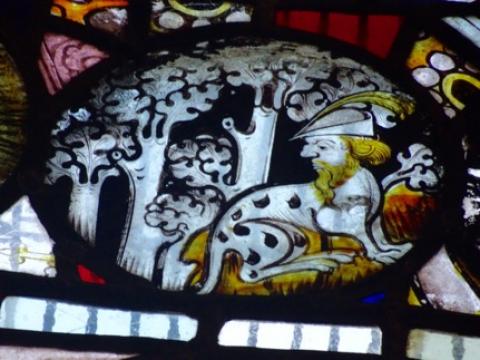Chaucer: Medieval Poetry and Modern Performance
Watching Chaucer at work, modern poet Lavinia Greenlaw says, is like meeting English "before the paint has dried." Before rules (even of spelling) have hardened. Before live oral performance is subordinated to written record.
Chaucer's poetry comes fully alive when read aloud. Each of you will gradually come to read and perform Middle English fluently and well. And this will give you a good idea of where modern English comes from: Middle English is the floor upon which, word by word, modern English walks; a frequent challenge is "etymologize that!" Our flower the daisy, for example, comes from the Old English dayes eye, "the eye of day"; the dandelion is from the French dent de lion ("the lion's tooth": such is the shape of its petals). Why do so many poets, especially women poets, and minority women poets, find Chaucer so imaginatively liberating? What is so special about Alisoun, the Wife of Bath? How does a return to English origins open the way to new English expressive futures? Sylvia Plath, Lavinia Greenlaw, Marilyn Nelson, Patience Agbabi, Jean Binta Breeze, Pattie McCarthy all have things to say here. Caroline Bergvall, author of wonderful Chaucerian poems in her Meddle English, is currently completing a chapbook called "Alisoun Sings"; we'll try to bring her to campus. You might be similarly inspired into creative response; your final assignment can take the form of a poem, video, screenplay, or you can write a traditional critical essay.
Our course will concentrate upon The Canterbury Tales, an amazingly varied framed collection of stories, juxtaposing knightly deeds of chivalry with low deeds of sexual opportunism; philosophical musing and tales of talking chickens; tales of liberty and tyranny; oriental exoticism and gritty, close-to-home realism; enlightened views of Islam and tales of wicked mothers-in-law; alchemy and magic; ecology and astronomy; saint's life and undergraduate escapade; freelance eroticism and married love. "Genre" never stabilizes in Chaucer, and there is no stable Chaucerian template: every new tale is a fresh adventure. We will develop a "slow cooking" habit of reading the text: better to go slowly and appreciate what is going on.
Form of Assessment: Assignment 1, in-class language test (10% of grade); assignment 2, translation and commentary, 20%; assignment 3, short essay, 20%; assignment 4, longer essay with research component, or creative project with production notes, 40% of grade; preparation and participation, 10%. There will be no midterm or final, and all assignments except the first will be submitted as .doc by e-mail, and will be graded via Track Changes. This will allow folks who need to travel for religious holidays to submit early, if necessary.
Text required:
Chaucer, The Canterbury Tales, ed. Jill Mann (Penguin), paperback.
Text not required:
David Wallace, Chaucer: A New Introduction (Oxford UP, 2017), cheap and short.

 Department of English
Department of English
